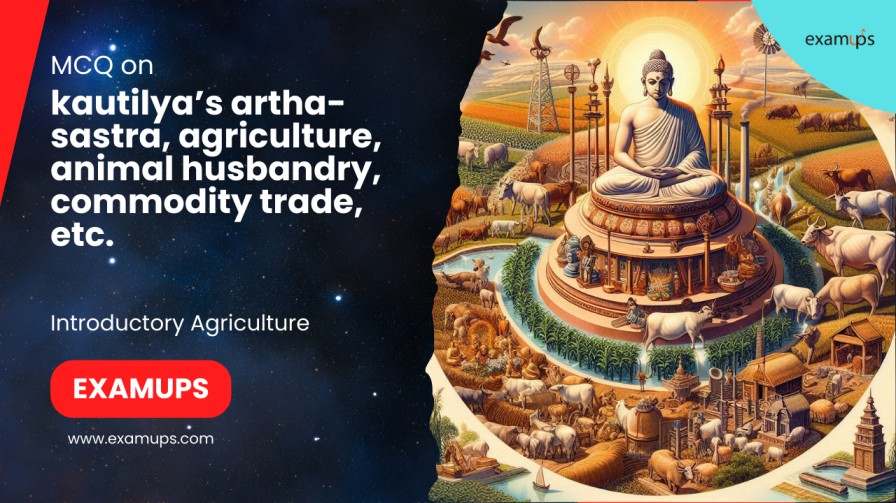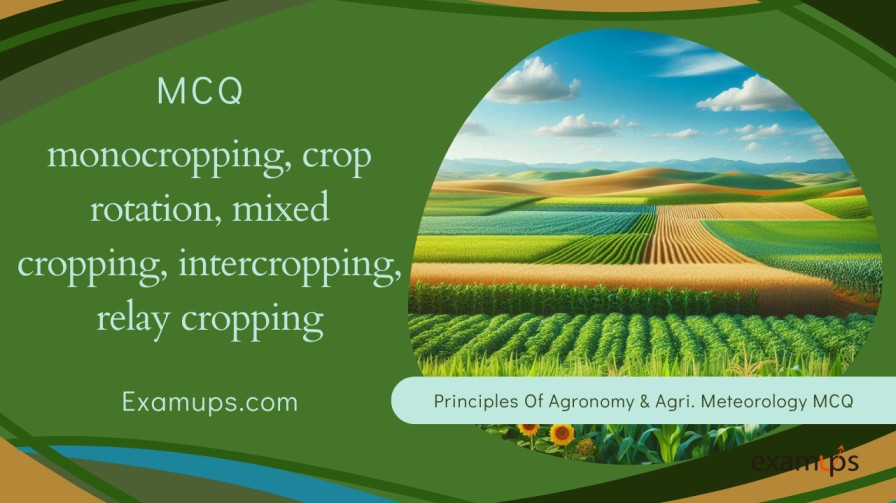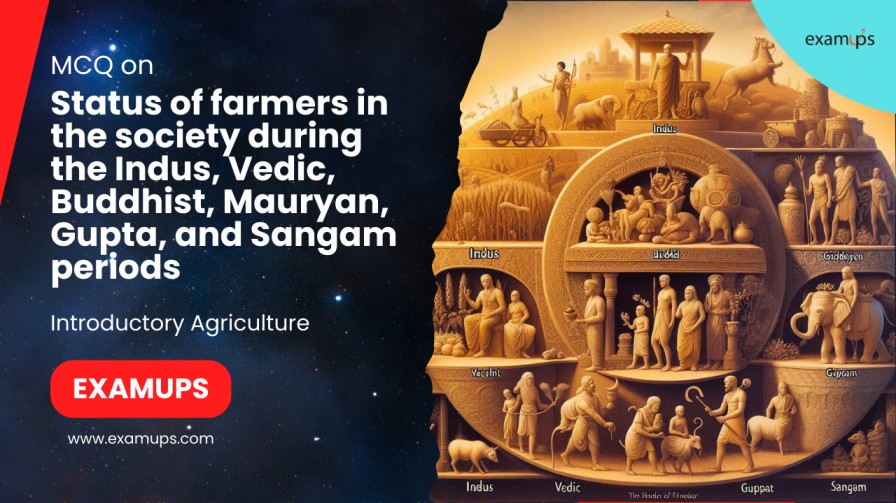MCQ on kautilya’s artha-sastra, agriculture, animal husbandry, commodity trade, etc. for ICAR-JEF, ICAR-SRF, ICAR-NET, IBPS-AFO/SO, Pre-PG, BHU Pre-PG, IFFCO-AGT, CCI, FCI, B.sc, M.sc, All Agriculture Competitive Exams.
1. During Kautilya’s time, which term encompassed agriculture, cattle breeding, and trade?
a) Arthashastra
b) Varta
c) Sitadhakashya
d) Chanakya
**Answer: b) Varta**
**Explanation:** During Kautilya’s time, agriculture, cattle breeding, and trade were grouped into a
science called Varta.
2. According to Kautilya, who should be appointed as the superintendent of agriculture?
a) A civil servant
b) A person with no expertise
c) A knowledgeable person in agriculture and horticulture
d) A person recommended by the king
**Answer: c) A knowledgeable person in agriculture and horticulture**
**Explanation:** Kautilya suggested that the superintendent of agriculture should be a person
knowledgeable in agriculture and horticulture.
3. What was the punishment for any delay in making arrangements for rainfed crop sowing, as per
Kautilya’s Artha-sastra?
a) Fine
b) Exile
c) Punitive action
d) Imprisonment
**Answer: c) Punitive action**
**Explanation:** Kautilya emphasized the importance of timely arrangements for rainfed crop
sowing and prescribed punitive action for any delay.
4. How was rainfall measured during Kautilya’s time?
a) Using modern rain gauges
b) Circular vessel called adhaka
c) By observing natural signs
d) Not measured
**Answer: b) Circular vessel called adhaka**
**Explanation:** Rainfall was measured during Kautilya’s time using a circular vessel called adhaka,
with specific units to measure rainfall.
5. According to Kautilya, what is the significance of the even distribution of rainfall during the crop
growing season?
a) It reduces the need for irrigation
b) It improves soil fertility
c) It enhances crop yield
d) It prevents soil erosion
**Answer: c) It enhances crop yield**
**Explanation:** Kautilya stressed the importance of even distribution of rainfall during the crop
growing season as it enhances crop yield.
6. Which crop did Kautilya suggest should be sown early in the season?
a) Wheat
b) Barley
c) Rice
d) Sugarcane
**Answer: c) Rice**
**Explanation:** Kautilya suggested that rice should be sown early in the season for optimal growth
and yield.
7. According to Kautilya, which crop requires the most attention and expenditure?
a) Rice
b) Millets
c) Pulses
d) Sugarcane
**Answer: d) Sugarcane**
**Explanation:** Kautilya stated that sugarcane requires the most attention and expenditure among
crops.
8. Where did Kautilya suggest crops like cucurbits are well suited to be grown?
a) Drylands
b) Desert areas
c) Banks of rivers
d) Mountain slopes
**Answer: c) Banks of rivers**
**Explanation:** Kautilya suggested that crops like cucurbits are well suited to be grown on the
banks of rivers due to the availability of moisture.
9. Which biocontrol practice suggested by Kautilya involves exposing seeds to mist and heat for seven
nights?
a) Seed treatment
b) Pest control
c) Disease management
d) Weed control
**Answer: a) Seed treatment**
**Explanation:** Kautilya suggested exposing seeds to mist and heat for seven nights as a biocontrol
practice, which is similar to modern seed treatment methods.
10. According to Kautilya, what should be done with harvested produce?
a) Left in the field
b) Sold immediately
c) Properly processed and safely stored
d) Fed to livestock
**Answer: c) Properly processed and safely stored**
**Explanation:** Kautilya advised that harvested produce should be properly processed and safely
stored to prevent spoilage or loss.
11. What term did Kautilya use to describe the head of agriculture in his Artha-sastra?
a) Sthitiadhikari
b) Sitadhakashya
c) Krayadhikari
d) Vartadhikari
**Answer: b) Sitadhakashya**
**Explanation:** Kautilya suggested the appointment of a separate post for the head of agriculture,
named Sitadhakashya.
12. What did Kautilya emphasize regarding the distribution of rainfall during the crop growing
season?
a) Majority of rainfall in the beginning of the season
b) Uniform distribution throughout the season
c) Majority of rainfall in the middle of the season
d) Majority of rainfall at the end of the season
**Answer: b) Uniform distribution throughout the season**
**Explanation:** Kautilya stressed the importance of uniform distribution of rainfall throughout the
crop growing season.
13. According to Kautilya’s Artha-sastra, what is the ideal condition for rainfed crop cultivation?
a) High rainfall throughout the year
b) Intermittent rainfall with dry spells
c) Heavy rainfall during sowing season
d) Moderate rainfall with even distribution
**Answer: d) Moderate rainfall with even distribution**
**Explanation:** Kautilya suggested that rainfed crop cultivation thrives under moderate rainfall
conditions with even distribution.
14. What was the role of the village council in Kautilya’s economic policies?
a) Decision-making authority for agriculture
b) Regulation of trade and commerce
c) Allocation of land for cultivation
d) Monitoring agricultural productivity
**Answer: b) Regulation of trade and commerce**
**Explanation:** Kautilya’s economic policies involved the village council in regulating trade and
commerce.
15. How did Kautilya suggest farmers should be compensated for their produce?
a) With monetary payment
b) With land grants
c) With goods or services
d) With tax exemptions
**Answer: c) With goods or services**
**Explanation:** Kautilya suggested that farmers should be compensated for their produce with
goods or services, as mentioned in his Artha-sastra.
16. Which biocontrol practice suggested by Kautilya involves plastering cut ends of sugarcane with a
mixture?
a) Companion planting
b) Crop rotation
c) Integrated pest management
d) Application of biopesticides
**Answer: d) Application of biopesticides**
**Explanation:** Kautilya recommended plastering cut ends of sugarcane with a mixture containing
honey, ghee, and cow dung as a biocontrol practice.
17. According to Kautilya, what was the main source of irrigation for agriculture?
a) Rainwater harvesting
b) River diversion
c) Well water
d) Canal systems
**Answer: c) Well water**
**Explanation:** Kautilya mentioned the use of wells for irrigation, indicating that well water was
the main source of irrigation for agriculture during his time.
18. What did Kautilya prescribe regarding the handling of above-ground crop residues?
a) Leave them in the field for soil enrichment
b) Burn them to clear the fields
c) Use them as animal fodder
d) Remove them from the fields
**Answer: d) Remove them from the fields**
**Explanation:** Kautilya advised removing above-ground crop residues from the fields and feeding
them to cattle.
19. How did Kautilya categorize industries in terms of ownership?
a) Public and private
b) State and communal
c) Collective and individual
d) Government and non-governmental
**Answer: a) Public and private**
**Explanation:** Kautilya categorized industries into public and private ownership in his economic
policies.
20. What did Kautilya recommend as the most effective measure for preventing soil erosion?
a) Terracing
b) Crop rotation
c) Afforestation
d) Well-planned irrigation
**Answer: c) Afforestation**
**Explanation:** Kautilya suggested afforestation as an effective measure for preventing soil erosion,
indicating his concern for environmental sustainability.
21. What term did Kautilya use to describe the ideal distribution of rainfall during the crop growing
season?
a) Varsha Samhati
b) Varsha Madhyama
c) Varsha Sankalpa
d) Varsha Pradhana
**Answer: b) Varsha Madhyama**
**Explanation:** Kautilya emphasized the importance of Varsha Madhyama, which means an even
distribution of rainfall throughout the crop growing season.
22. According to Kautilya’s Artha-sastra, what was the purpose of exposing seeds to mist and heat for
seven nights?
a) To enhance seed germination
b) To prevent seed decay
c) To increase seed viability
d) To deter pests and diseases
**Answer: a) To enhance seed germination**
**Explanation:** Kautilya recommended exposing seeds to mist and heat for seven nights to
improve their germination rate.
23. What was the primary role of the superintendent of agriculture according to Kautilya?
a) Planning crop rotations
b) Managing irrigation systems
c) Overseeing agricultural operations
d) Implementing pest control measures
**Answer: c) Overseeing agricultural operations**
**Explanation:** The superintendent of agriculture was responsible for overseeing various
agricultural operations, as mentioned by Kautilya.
24. Which factor did Kautilya consider essential for determining the appropriate time for harvesting
crops?
a) Soil moisture content
b) Crop maturity
c) Weather forecast
d) Solar position
**Answer: b) Crop maturity**
**Explanation:** Kautilya suggested that crops should be harvested at the appropriate time based
on their maturity level.
25. How did Kautilya suggest farmers should manage harvested produce to ensure its safety?
a) Store it in underground pits
b) Use chemical preservatives
c) Process and package it properly
d) Keep it exposed to sunlight
**Answer: c) Process and package it properly**
**Explanation:** Kautilya recommended processing and safely storing harvested produce to
maintain its quality and safety.
26. According to Kautilya, what was the significance of the circular vessel used to measure rainfall?
a) To calculate agricultural taxes
b) To predict weather patterns
c) To estimate crop yields
d) To assess irrigation needs
**Answer: d) To assess irrigation needs**
**Explanation:** The circular vessel mentioned by Kautilya was used to measure rainfall and assess
the irrigation requirements for agriculture.
27. Which biocontrol practice suggested by Kautilya involved soaking seeds in water before planting?
a) Seed priming
b) Seed coating
c) Seed fumigation
d) Seed scarification
**Answer: a) Seed priming**
**Explanation:** Kautilya recommended soaking seeds in water before planting as a biocontrol
practice to activate fungal mycelia and improve germination.
28. How did Kautilya suggest farmers should manage the residues left after harvesting crops?
a) Use them as fuel for cooking
b) Incorporate them back into the soil
c) Sell them in the market
d) Feed them to livestock
**Answer: d) Feed them to livestock**
**Explanation:** Kautilya advised farmers to remove above-ground crop residues and feed them to
livestock, indicating their potential as animal fodder.
29. What was the role of the village council in Kautilya’s economic policies?
a) Determining crop prices
b) Allocating agricultural land
c) Regulating trade and commerce
d) Providing agricultural subsidies
**Answer: c) Regulating trade and commerce**
**Explanation:** Kautilya’s economic policies involved the village council in regulating trade and
commerce within the community.
30. What was the term used by Kautilya to describe the science encompassing agriculture, cattle
breeding, and trade during his time?
a) Vartika
b) Artha-sastra
c) Varta
d) Rajaniti
**Answer: c) Varta**
**Explanation:** Kautilya grouped agriculture, cattle breeding, and trade into a science called
“Varta” in his treatise Artha-sastra.
31. According to Kautilya, what was the primary responsibility of the state government in relation to
agriculture?
a) Directly managing agricultural production
b) Providing subsidies to farmers
c) Controlling and regulating economic aspects
d) Investing in agricultural research
**Answer: c) Controlling and regulating economic aspects**
**Explanation:** Kautilya suggested that the state government should control and regulate the
economic aspects of agriculture to prevent the influence of market forces and private interests.
32. In Kautilya’s Artha-sastra, what term did he use to refer to the person responsible for overseeing
agriculture?
a) Sitadhakashya
b) Krishi Pramukh
c) Varta Nideshak
d) Artha Adhyaksha
**Answer: a) Sitadhakashya**
**Explanation:** Kautilya recommended appointing a person knowledgeable in agriculture as the
superintendent of agriculture, known as “Sitadhakashya.”
33. What action did Kautilya suggest for maintaining soil texture required for crops?
a) Soil amendment with organic matter
b) Regular ploughing
c) Crop rotation
d) Irrigation management
**Answer: b) Regular ploughing**
**Explanation:** Kautilya emphasized thorough ploughing to maintain the soil texture necessary for
crop cultivation.
34. According to Kautilya, what was the primary determinant of the distribution of rainfall during the
crop growing season?
a) Geographical location
b) Solar radiation
c) Seasonal changes
d) Monsoon patterns
**Answer: d) Monsoon patterns**
**Explanation:** Kautilya suggested that rainfall distribution during the crop growing season was
primarily determined by monsoon patterns.
35. What did Kautilya recommend for the optimal sowing time of different crops?
a) Sowing based on astrological signs
b) Sowing during specific lunar phases
c) Sowing according to soil moisture levels
d) Sowing based on traditional practices
**Answer: c) Sowing according to soil moisture levels**
**Explanation:** Kautilya suggested sowing crops at the commencement of rain, depending on the
soil moisture levels required for each crop.
36. Which crop management practice did Kautilya associate with higher labor expenses?
a) Rice cultivation
b) Wheat cultivation
c) Sugarcane cultivation
d) Millet cultivation
**Answer: c) Sugarcane cultivation**
**Explanation:** Kautilya noted that sugarcane cultivation required more labor and expenditure
compared to other crops.
37. How did Kautilya recommend farmers manage harvested produce to prevent wastage?
a) Immediate consumption
b) Proper processing and storage
c) Donation to the needy
d) Sale at local markets
**Answer: b) Proper processing and storage**
**Explanation:** Kautilya suggested processing and safely storing harvested produce to prevent
wastage and ensure its longevity.
38. Which economic policy category did agriculture fall under according to Kautilya?
a) Privately owned industries
b) State-controlled industries
c) Cottage industries
d) Foreign trade
**Answer: a) Privately owned industries**
**Explanation:** Kautilya categorized agriculture as a privately owned industry in his economic
policies.
39. In Kautilya’s Artha-sastra, what term did he use for the separate post responsible for overseeing
agriculture?
a) Sitadhakashya
b) Krishi Pradhan
c) Kisan Adhyaksha
d) Krishi Sanchalak
**Answer: a) Sitadhakashya**
**Explanation:** Kautilya suggested the establishment of a separate post known as Sitadhakashya to
manage and oversee agriculture.
40. According to Kautilya’s Artha-sastra, what punitive action could farmers face for delays in
arranging implements and accessories for sowing?
a) Heavy fines
b) Confiscation of land
c) Loss of farming privileges
d) Forced labor
**Answer: d) Forced labor**
**Explanation:** Kautilya’s Artha-sastra mentions punitive actions such as forced labor for farmers
who failed to arrange implements and accessories for sowing in time.
41. Which crop did Kautilya suggest requires the least labor expense?
a) Rice
b) Vegetables
c) Sugarcane
d) Pulses
**Answer: d) Pulses**
**Explanation:** Kautilya stated that pulses require the least labor expense compared to other crops
like rice, vegetables, and sugarcane.
42. What did Kautilya recommend for harvesting crops to ensure nothing is left in the field?
a) Threshing
b) Winnowing
c) Manual picking
d) Mechanical harvesting
**Answer: c) Manual picking**
**Explanation:** Kautilya recommended manual picking during harvesting to ensure that nothing is
left in the field after harvesting.
43. How did Kautilya categorize industries in terms of ownership in his economic policies?
a) Public and private
b) State-owned and cooperative
c) Rural and urban
d) Domestic and international
**Answer: a) Public and private**
**Explanation:** Kautilya’s economic policies categorized industries into public (state-owned) and
private sectors.
44. According to Kautilya, what was the primary role of the state government in regulating
agricultural production?
a) Direct ownership of agricultural land
b) Providing subsidies to farmers
c) Controlling production and distribution
d) Encouraging private investment in agriculture
**Answer: c) Controlling production and distribution**
**Explanation:** Kautilya suggested that the state government should control and regulate
agricultural production and distribution to evade the influence of market forces and private interests.










